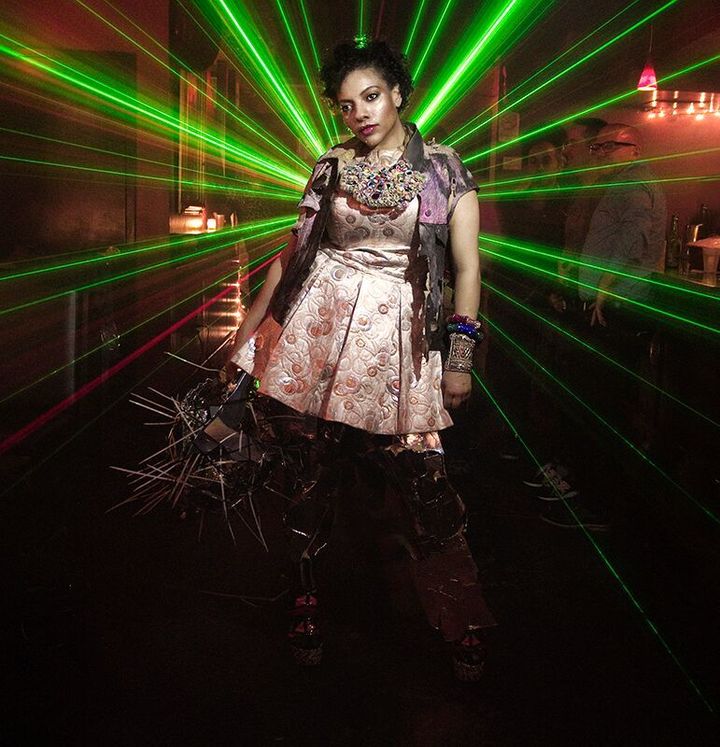
The Pulsar (Abigail DeVille), 2014. Archival pigment print. Courtesy of the artist.
On view at The 8th Floor, the lush, elaborately staged photographic portraits that comprise Elia Alba’s project, The Supper Club (2012-present), are a testament to the power of community and kinship. Like Nan Goldin’s The Ballad of Sexual Dependency (1979-1986), Catherine Opie’s Portraits Series (1993-97), and Ryan McGinley's The Kids Were Alright (1998-2003), they offer a sustained, intimate look at a circle of friends, and elevate them to mythic status. But whereas such predecessors focused their lens on queer and youth subcultures, capturing them in candid, often spontaneous poses, Alba trains hers on fellow artists of color (some queer and young too), creating collaboratively produced, allegorical portraits.
A multimedia artist, Alba is as impressively adroit in sewing, installation, and sculpture as she is in photography, and this facility is evident in the handcrafted props and costumes that appear in many of her portraits. The sometimes fantastical mise en scènes that enshrine her diverse subjects evoke a variety of influences from art history and Afrofuturism to fashion photography and classical mythology. All are forged from an alchemy of symbols that Alba summons to represent each person’s unique artistic contributions and personality. Even the locations function symbolically. To date there are 60 portraits that comprise this series, including luminaries such as Mickalene Thomas, Chitra Ganesh, Jacolby Satterwhite, Coco Fusco, Jeffrey Gibson, Lorraine O’Grady, Derrick Adams, Kalup Linzy, Latoya Ruby Frazier, Niv Acosta, Simone Leigh, and Abigail Deville, to name a few.
Alba’s commitment to involving each artist-subject in the making of their portrait has shaped the resulting images as much as her own archetypal sensibilities. Less visible an influence, if just as defining, are the contemporaneous dinners Alba has organized since she began The Supper Club project, and which account for its name. These unfettered dialogues, at first casual and spontaneous, grew to encompass more formal discussions with guest lists designed around particular themes. As the galvanizing force behind these communal meals, Alba has given hundreds of artists of color the opportunity to discuss personal, political and cultural issues in a safe and supportive space. In a predominantly white art world riddled with unexamined racism, and lacking in intersectional awareness, such opportunities are sadly rare. These dinners will no doubt be remembered by guests as offering a much-needed sanctuary, and their legacy lives on in Alba’s remarkable portraits.
Wanting to honor the generosity and vitality of Alba’s utopian vision, and her devotion to building communal platforms for artists of color, I sat down with the artist to talk about the genesis and evolution of The Supper Club.
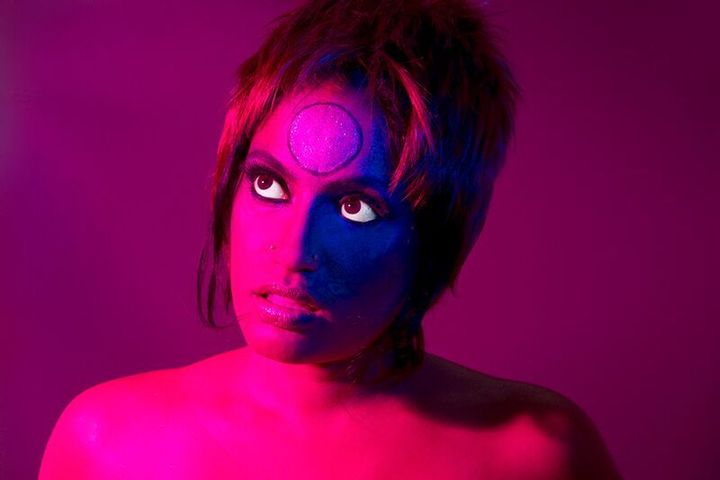
The Dreamweaver (Chitra Ganesh), 2013. Archival pigment print. Courtesy of the artist.
JH: The Supper Club began in 2012 as a photography-based project, which then inspired the group dinners that the exhibition’s title alludes to. Can you talk about this transition?
EA: The dinners initially were meant to give voice to the artists I was photographing and to create a platform for their cultural concerns. However, the first dinner in 2012 was eye opening for me as there were multiple positions being addressed and put forward. I remember Nicole Awai saying that she felt like she represented “the good Black” and how uncomfortable she was with this, and Simone Leigh talking about her choice to not identify as Jamaican American because “it’s very privileged to be something other than Black American, especially in the art or the academic world.” That was a powerful moment for me. After that, I knew I needed to continue these conversations so people could delve deeper into the issues they brought up.
Until late 2014, the dinners focused on how artists saw themselves, and revolved around issues of agency, the role of artists, identity and audience. However, the killing of Trayvon Martin in 2012 left a huge impact on me, and with the killings of Michael Brown and Eric Garner in 2014, at that point, I felt I could no longer host dinners and just talk about identity in the art world. I wanted to talk about how people relate to each other, and how they related to actual events. At this time, I started cooking the dinners.
JH: Yes, to date you’ve organized at least 25 dinners, making many of the meals yourself, as you mention. To help set the mood, can you tell us what sort of food you served, and how you chose your guest list as well as the topics discussed?
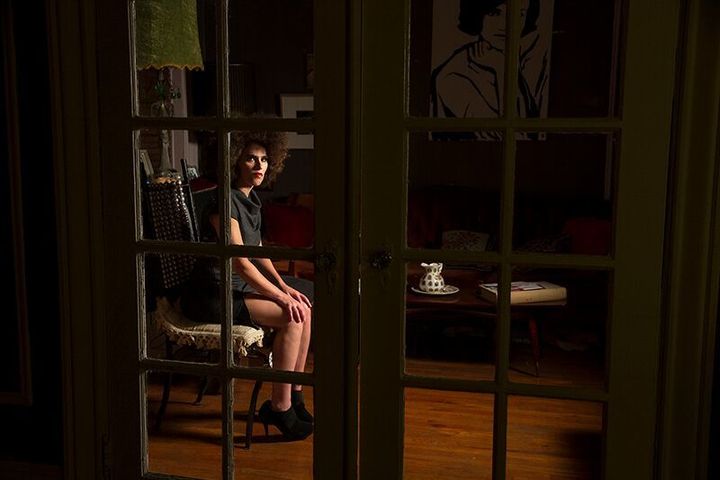
The Culturalist (Karina Skvirsky), 2014. Archival pigment print. Courtesy of the artist.
EA: At first The Supper Club met at restaurants or gathered for take-out food. When I decided to discuss broader politics, I felt the best way to do this was to cook the dinners myself. I wanted artists to come to the table, and be open to discussing serious matters. I feel that there is something about a home-cooked meal that brings people together, like family. I often make empanadas as my signature, and I’ve served roasted vegetables, grilled meats, rice, salads, food that can be passed around the table, rather than plated. This gives a chance for guests to interact with one another more.
As far as the guest lists, initially I was only inviting the artists I was photographing so the selection of guests depended on who could attend. It wasn’t until late 2014, when the conversations shifted to socio-political events, that I started to invite outside of the group I was photographing. I began to curate the dinner guests based on the topic of conversation. I also started inviting hosts who would help to create the guest list, provide the prompts for discussion and guide the conversation. For example, Derrick Adams and Clifford Owens hosted a dinner in early 2017 on black male subjectivity and representation in art and everyday life, exploring how we might rethink and reimagine them as well as ideas around black male communion and black male community. In Spring 2017 historian Brandi Summers hosted a night on Black Female Subjectivity, addressing the quotidian and radical consciousness of black womanhood. In the summer of 2017, activist and writer, Sur Rodney Sur hosted a dinner called “What would an HIV doula do?” The conversation asked the dinner guests to express their feelings and actions on the ongoing AIDS pandemic. And after the Orlando tragedy in the summer of 2016, curator and DJ Edwin Ramoran hosted a dinner on Sanctuary and Safety.
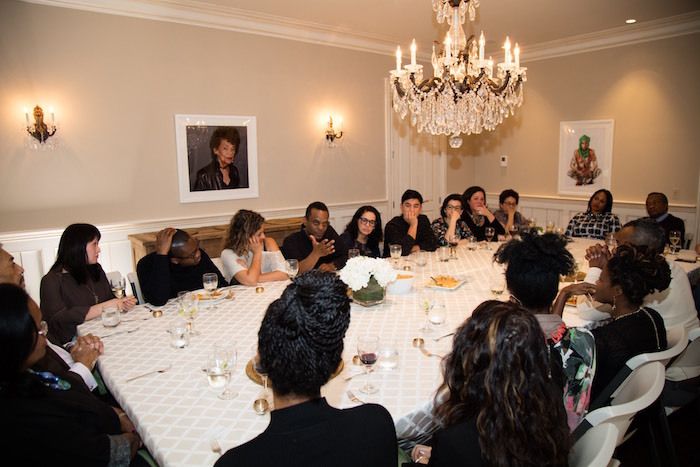
Dinner organized on March 13, 2016 at the home of collector Jessica Stafford Davis McLean in Virginia, outside Washington DC. Discussion topic: Prospects of race relations post-Obama.
JH: Your investment in community-building, dialogue, and collaboration underscore not only the dinners but the portraits as well. Each image is an elaborate negotiation with your artist-subject as to what location, props, set design, costumes, etc. would best express their essence - as artists, and individuals. Why is this staging so important to you?
EA: For me staging a photograph is similar to painting a canvas, and creating a decisive moment. Photography doesn’t always have to be spontaneous, in other words, documenting a moment as its happening. It is a creation built with the imagination of the photographer. I didn’t just want to document the artists in a straightforward manner or depict working in their studios. I wanted to tell a story and make the artists into iconic archetypes that embody their persona and their practice. The staging of the photographs not only highlighted each unique individual, but also created a platform that connects them to the world.
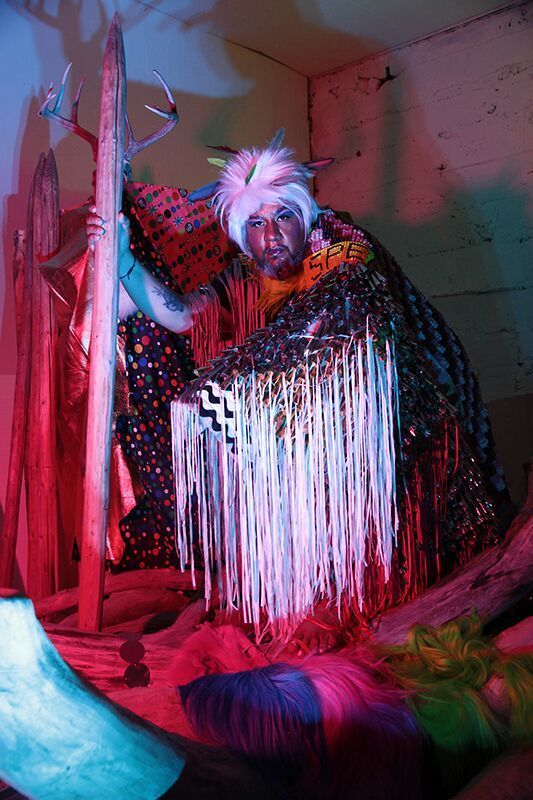
The Disco Shaman (Jeffrey Gibson), 2015. Archival pigment print. Courtesy of the artist.
JH: Connects them how?
EA: The portrait of LaToya Ruby Frazier, taken in 2012 in the Carnegie Library in Braddock PA, for example, was very much informed by the great Barkley Hendrick’s seminal painting, “Lawdy Mama”, that beautiful image of a young black woman with a large afro as a kind of saint. For me I saw LaToya like the patron saint of Braddock. Through her community and her family, her photographs portray systemic problems from racism to environmental degradation. She shines a light not only on the ills of her community but also of many postindustrial towns and cities throughout the United States that have suffered and continue to suffer similar plight. Though Hendricks said the sitter in his painting was a cousin to many viewers, the subject has been alternately identified as Angela Davis or Kathleen Cleaver, the later another influence on my portrait of LaToya.
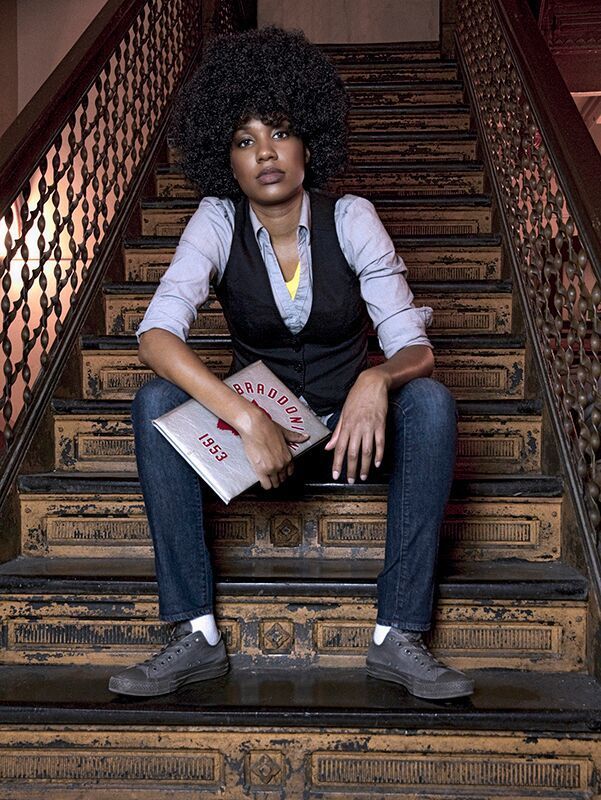
The Braddonian (LaToya Ruby Frazier), 2012. Archival pigment print. Courtesy of the artist.
JH: At The 8th Floor, you’ve arranged the 60 portraits that comprise The Supper Club into thematic groupings: The Afrofuturists; Shadows and Moonlight; Masculinity; The Cinematic; Fantasy; Mythology; The Comedians; Intellectuals; The Archetypes; In Nature. What do these categories represent to you?
EA: To be frank I only had loose categories in mind when I started. Once the images were taken, I was able to step back and see more connections between them, sometimes based on subjects’ practice as artists, but more often in the way I was choosing to represent them. For example, Rachelle Mozman (The Ethnographer) and Sanford Biggers (The Syncretist), are both part of “In Nature” despite obvious differences. Mozman’s photographic portraits are cultural and psychological studies that rely on the surreal, hence the Alice in Wonderland reference in her image, which alludes to lost innocence and death. Sanford Biggers, on the other hand, makes work that brings together multiple themes; hip hop, politics, race, rebirth and spirituality, and in his portrait , we alluded to the African American tradition of river baptism. So its my interpretation of their work that connects them to this nature theme.
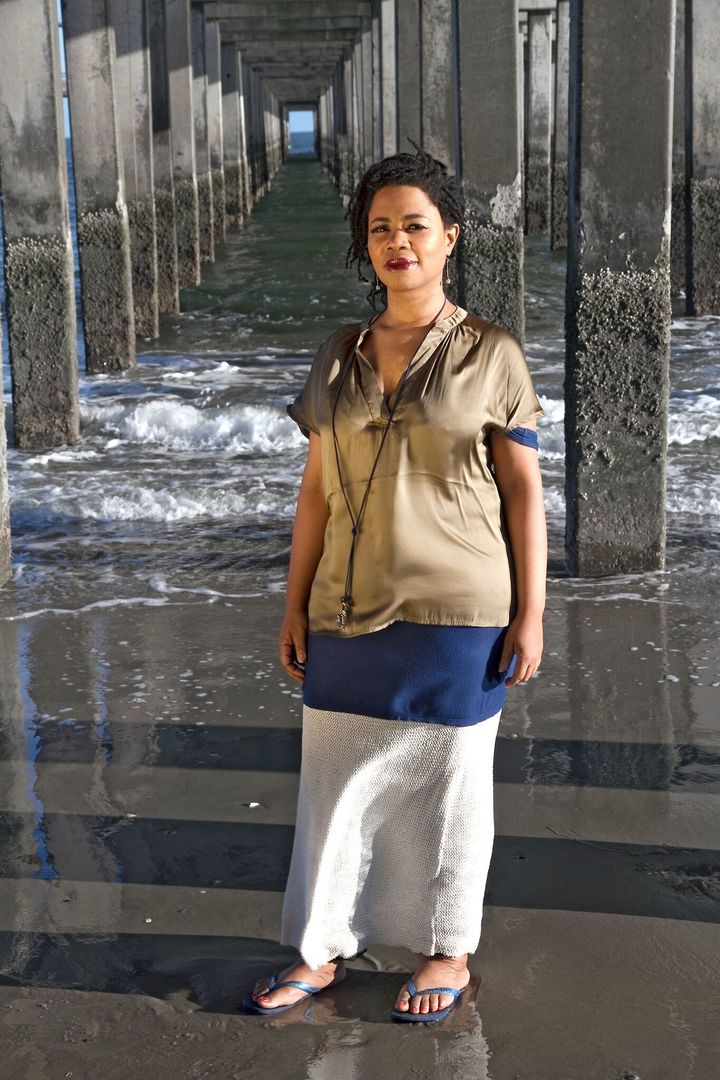
The Kaisonian (Nicole Awai), 2014. Archival pigment print. Courtesy of the artist.
JH: I spotted many art historical references throughout the exhibition, from Sir John Everett Millais’ Ophelia, 1852 (The Botanist, Lina Puerta); Auguste Rodin’s The Thinker, 1901 (Zachary Fabri),; and Botticelli’s Birth of Venus, 1484-86 (The Female Gaze, MIckalene Thomas) to Caravaggio’s Sick Bacchus, 1593 (The Feeler, Ivan Monforte), and Frida Kahlo’s Two Fridas (Iliana & Scherezade Garcia). How do these references function for you, both in terms of your relationship to the canon, and its omissions?
EA: My photographs raise questions about race, gender, and the politics of representation by portraying contemporary artists of color within these art historical references that draw attention to the absence of people of color not only within history but in contemporary media. That said, they were not meant to ever be literal references, although some are obvious, but more of a re-contextualizing of those references, and the meaning behind those references.
JH: Can you explain how this re-contextualizing plays out in some of your more obvious references?
EA: The use of multiple meanings can be found throughout my work and this series is no exception. I am interested in fluid notions of being and meaning, where it’s hard to pin point exactly what is being referenced. In the portrait of Ivan Monforte, The Feeler, for example, I reference Caravaggio’s Sick Bacchus but also Parmigianino’s Madonna of the Long Neck. Ivan here is reimagined as a sad gay Madonna, in part because the nature of his work about disenfranchised members of the LGBT community, and its themes of sexuality, love, sex, and loss. The three-quarter view of the face was among those preferred for late Renaissance portraiture, and like Sick Bacchus, Ivan’s face and the tilt of his head convey a real sense of suffering, again alluding to his work as well as his own personal history of illness.
With Shaun Leonardo, I wanted to re-consider classical models of male representation. At the time of this photograph, Shaun’s works and performances, through the context of sports, used his body to convey images of hyper-masculinity and associated cultural stereotypes. For me nothing represents the classical hyper-masculine ideal more than Michelangelo’s David. This work of art, unlike others of its time which depicted David after the battle, often standing victoriously with a severed head of Goliath, shows a David at a point in time that anticipates victory; the space of conscious choice and conscious action, evoking the psychological essence of competitive sports, and his current work on self-defense and care.
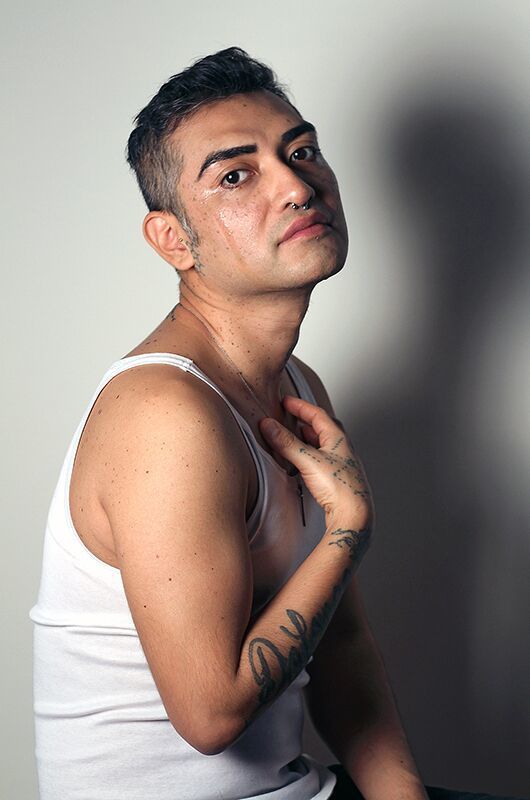
The Feeler (Ivan Monforte), 2014. Archival pigment print. Courtesy of the artist.

The Hero (Shaun Leonardo), 2014. Archival pigment print. Courtesy of the artist.
JH: Light is fundamental to all photographers, and your work, which possesses a masterful sense of color, is no exception. The wall text cited the influence of fashion photography on your aesthetic. How does that manifest for you?
EA: Fashion for me has a symbiotic relationship with art photography. I shot many of these photographs using the language of fashion editorials to show how it can exist in other forms, and how the context can be broadened. Fashion photography is fascinating to me due to its construction of image, the likeness is real time but it’s completely hyperreal with many elements of fantasy. Fantasy has been a driving element in all my work. There’s also an element of performance in fashion photography, which allows for a blending of style and role-play that is unique to it. In many ways, the artists were asked to role play their persona for my images.
JH: What are your plans for the future of this project?
EA: I am working on a book with Rubin Foundation and Hirmer on The Supper Club slated for publication in Fall of 2018. In June 2018, I will be presenting 18 of these images in collaboration with LMCC and DOT, as part of a large-scale outdoor installation as well as co-curating an exhibition at LMCC’s newly revamped Governor’s Island location. I will be working with The Friends of The High in the summer to host two dinners. In addition, I am working on a new series of portraits in which I will continue to work with artists and other cultural producers, and utilize their practice and persona as a point of departure, but these photographs will include elements of their personal historical narrative.
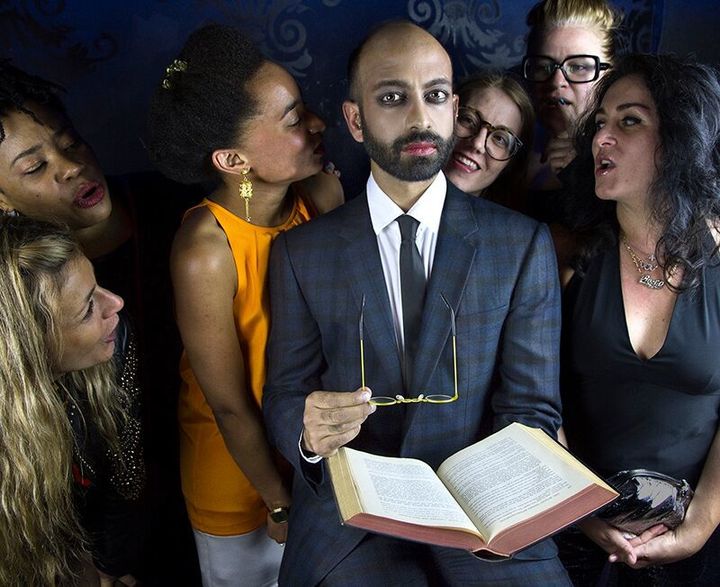
The Linguist (Brendan Fernandes), 2014. Archival pigment print. Courtesy of the artist.
The Supper Club was curated by the Executive and Artistic Director of The Shelley & Donald Rubin Foundation, Sara Reisman, and is on view at the Foundation’s exhibition space, The 8th Floor, through January 13, 2018.
